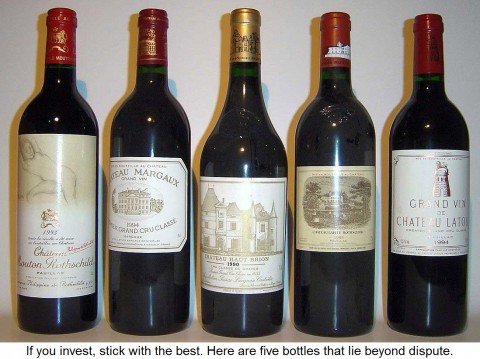[Gary Leibowitz, a regular in the Rick’s Picks forum, has a knack for attracting hostile fire. An unrelenting optimist in a bear’s lair, he is a guy who consistently raises everyone else’s hackles. In the guest commentary below, however, he digresses on a topic that all of us can take pleasure in – not just for its own sake, but as an investment. RA]
Can you guess what investment has outperformed the S&P 500 by more than 300% over the last 30 years? This asset has risen steeply in value when stocks were in a bull market, but it has fallen only half as steeply during bear markets. When I first stumbled on it about 25 years ago, I didn’t even consider it as an investment. Instead, I treated it like a hobby, one that I still enjoy. This particular investable requires only that one diversify into five sub-classes, and that one store it in a safe environment. In the end, you will be able to either sell it in a fairly liquid market, or you can simply pee it away as you enjoy it.
If I have confused you, it was intentional. My mention of five investment categories may have helped you guess what I was talking about. Here they are: Chateau Margaux, Chateau Lafite Rothschild, Chateau Mouton Rothschild, Chateau Haut Brion, and Chateau Latour. To invest in these Bordeaux you need not be an expert, or even have a trained nose. All that is required is that you store the bottles in a somewhat humid environment at around 55 degrees. If you have a proper place at home that fits the bill, great. But you can also buy an inexpensive wine cooler to keep the temperature constant. As for being savvy about each year’s grape harvest, in most case this will not even be necessary, for only very seldom did vintages fail to keep up with other investments like the S&P 500. If you want to pick and choose your wines for maximum potential return, subscribe to a wine newsletter or magazine such as the wine Advocate or Spectator. Robert Parker is the one man who can make or break a wine’s reputation, and so his advice should be used first.
‘Never Fall in Love’
The only downside is the risk of falling in love with your investment. As the old investment saying goes, never fall in love — be calculating and prudent. Now there’s the rub. Some 25 years ago, I frequented a wine store as a complete neophyte for the sole purpose of purchasing a bottle for my BYOB dinner reservation. I was in midtown and the shop I visited displayed all five first-growth wines, price at around $55 each. I’d always been considered a very impatient person, and on an impulse I purchased these five bottles, plus a white burgundy for the evening’s affair. I didn’t actually think this through, since I later realized that I’d have to hold onto them for a decade or more to get the full flavor and experience. I must confess that my biggest weakness has been, and will always be, food. I only became interested in wine after this impulsive purchase. I never considered bottles of wine as an investment. I had simply wanted to see what all the fuss was about in pairing great wines with food, and I knew these were the grand “almost-anything-goes-with-it” wines. I also fantasized about going to a restaurant like 11 Madison and finding the right food to complement a 15-year-old bottle. Well, I did tell you I was a weak man when it comes to patience. To my surprise, I held onto these bottles for a decade before starting to open them up. In that decade of waiting I discovered the world of wine and my own tastes. I must confess that the ability to smell and taste the subtlest nuances of various wines is not my gift. Without becoming a connoisseur, all I knew was what I liked (or didn’t). As for the five “starter” bottles, I do recall each one and what I ate. One of them, the last, turned out to be a disaster. I waited too long to drink it. It was a Latour. The cork had been ruined and a vinegar taste lingered in my mouth.
In conclusion, this is one investment you do not want to fall in love with, for if you do, all of your potential profits will be washed away in a moment.
Click here for details concerning the upcoming Hidden Pivot Webinar in September (and a $50 discount coupon if you register now].


ter:
“less than noble vinifera”.
I would not agree with that categorization as such.
Traminer and Gewuerztraminer are sometimes used interchangeably, so it’s hard to know which one is actually set.
Silvaner, OTH, can be grown for yield, not quality, but when the latter is the goal, can produce some very fine wines.
A bad connotation is prob. still lingering from the overproduction days decades ago, both in Alsace and Germany.
The grape was recently added to the permitted Alsace Grand Cru varietal list (small scale only).
In Franconia, there are many first rate growers that produce high quality from it.
So, not quite as blanket as all that.
In this specific instance, and given the high degree of ripeness usually permitted, the result is usually pretty good (did a multi-year tasting there quite some time ago….).
On the Gewuerztraminer pairing:
Alsatian food is many things, but spicy, in the Indiain/Thai/latin sense it is not, yet it is one of the high-class staples there. Thus it works well with other types too.
Hearty food as well, if you think of a choucroute platter.
(seeing as it’s lunch time, I better not).
And great dessert-wines of course too.